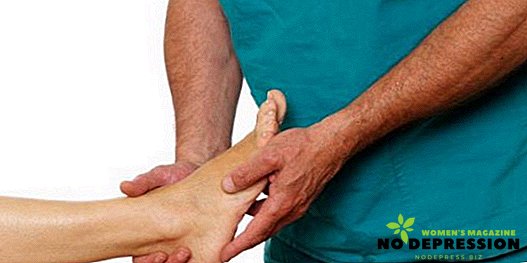Diabetic foot is one of the late complications of diabetes, characterized by pathological changes in the tissues of the foot. According to statistics, 8-10% of patients with diabetes mellitus suffer from this syndrome, and 50% of these patients are at risk.
When blood sugar is elevated for a long time, dysfunction of large and small vessels of the legs occurs. In the future, this leads to disruption of all the tissues of the lower extremities - bone, muscle, as well as changes in the structure of the skin.

All this is the basis for rapid infection, resulting in the formation of ulcers, cellulitis and even gangrene. The latter leads to indications for limb amputation, after which the person becomes disabled.
There are three types of diabetic foot:
- Neuropathic - damage to the nervous tissue prevails;
- Ischemic - circulatory disorders;
- Mixed - both previous views are combined.
The main causes of complications
- Peripheral neuropathy.
In simple words - damage to the nerves of the lower extremities, people suffering from diabetes for more than 10 years are at risk of such complications. When the nerves of the legs are damaged, the patient does not feel his limbs fully. Consequently, if the shoes are uncomfortable, or are rubbing them - the diabetic simply does not pay attention to this, he does not feel it. Therefore, scratches, corns and bellies are detected late.
- Disturbance of blood circulation.
Poorly controlled diabetes, as mentioned above, violates the functions of small and large vessels of the legs (veins, arteries). This leads to atherosclerosis, in which rapid healing and healing take longer.

- Foot injury.
Any damage and injury to the foot is very dangerous with diabetes, even a small cut or scratch can not be ignored.
- Fungal infections.
They can lead to serious complications in the form of bacterial infections, so the fungus must be treated.
- Ingrown nail.
This happens more often when wearing tight shoes. If you do not notice the process of ingrowth in time, then infection of the soft tissues of the finger, and then the entire foot, can begin.
What are the symptoms
At the very beginning of the development of diabetic foot, the patient does not experience any painful sensations, since most of the nerve endings of the foot no longer produce pain impulses, as they have already died.
This is the danger of this disease - the inconspicuous onset of the disease, which gives no reason to turn to a specialist. Further, the following signs are observed:
- Swelling of the foot;
- Redness;
- Tingling and crawling;
- Chilliness of the feet;
- Cramps.
At the stage of manifestation of all these signs, treatment can be carried out, more often it is reversible. But if you miss these symptoms, the process develops further, starting with the appearance of superficial ulcers, which then penetrate deeper into the subcutaneous fatty space.
Further, the pathological process reaches the tendons, joints and bones. Severe complications of diabetic foot - osteomyelitis and gangrene.
Stages of diabetic foot
Stage 0 - the foot is deformed, calluses and corns are formed, the skin is pale and cold to the touch. Ulcers are not yet formed.
Stage 1 - surface ulcers occur, the underlying tissues are not affected.
Stage 2 - the ulcer affects not only the skin, but also the subcutaneous fatty tissue, muscle tissue and tendons.
Stage 3 - the ulcer penetrates further, reaches the bone.
Stage 4 - a limited area of the foot turns dark blue or black - this is gangrene. It is small at this stage and has clearly defined contours.
Stage 5 - Gangrene goes to the entire surface of the foot and extends above - to the lower leg.

Diagnostics
Such specialists as the endocrinologist, neuropathologist, and surgeon deal with the diagnosis of diabetic foot.
| History taking | It turns out the duration of the disease, whether there was a trauma to the lower limbs, etc. |
| Inspection | In order to make such a diagnosis, the doctor examines the patient's feet for damage, ulcers, and so on. Be sure to look around the shoes, estimated its size, convenience. The sensitivity of the lower limbs to mechanical stimuli, temperature changes, and vibrations is checked. |
| Laboratory research methods | If there is a wound, its contents are sent for bacteriological examination for further administration of drugs. Also general and biochemical blood tests are taken, blood for glucose level. |
| Instrumental research methods |
|
Diabetic Foot Treatment
Treatment of this disease can be both conservative (drugs) and operational. The approach depends on the stage of the developing syndrome.
Conservative treatment includes:
- Maximum normalize blood glucose levels.
- Antibiotics that are prescribed on the basis of bacteriological examination of the contents of an ulcer or wound.
- Analgesics to reduce pain (Ibuprofen, Ketorol, Analgin)
- Drugs that improve microcirculation (Trental, Agapurin).
- Antiseptic and antibacterial drugs for local use (hydrogen peroxide 3%, chlohexidine 0.05%).
For severe lesions of the lower extremities that are not susceptible to conservative therapy, surgical intervention is indicated. It is of several types:
- Angioplasty and stenting. This method is used in severe gangrene, as a way to save limbs.
- Vascular shunting. Conducted to improve blood circulation in blood vessels.
- Skin plastics. After excision of the dead foot taken of the foot, the wound surface is closed with a healthy skin flap.
- Amputation of the limbsti. The site of amputation depends on the distribution of the pathological process.
Prevention
- First of all, it is obligatory to control the level of sugar in the blood, diet and timely taking of drugs.
- Shoes only comfortable, closed. If summer time, be sure to breathe. Heels no higher than four centimeters.
- In no case do not use traumatic devices, such as pumice, or any kind of scrubs for skin care.
- It is necessary to monitor the hygiene of the feet.
- It is desirable to do a pedicure at home, in order to avoid the risk of infection.
- Trim toenails straight, do not round off the corners.
- Every day, independently do foot massage and gymnastics.
- If the skin of the feet is dry, then with the help of a doctor you can pick up special moisturizers.
- Promptly treat fungal feet.
- Moving lifestyle.

Diabetic foot syndrome is extremely dangerous for humans. If you find signs of this syndrome and start treatment on time, the risk of progression is minimal. With the running form and the absence of treatment, the patient faces disability.
Additional information about the diabetic foot from the doctor - in the next video.












